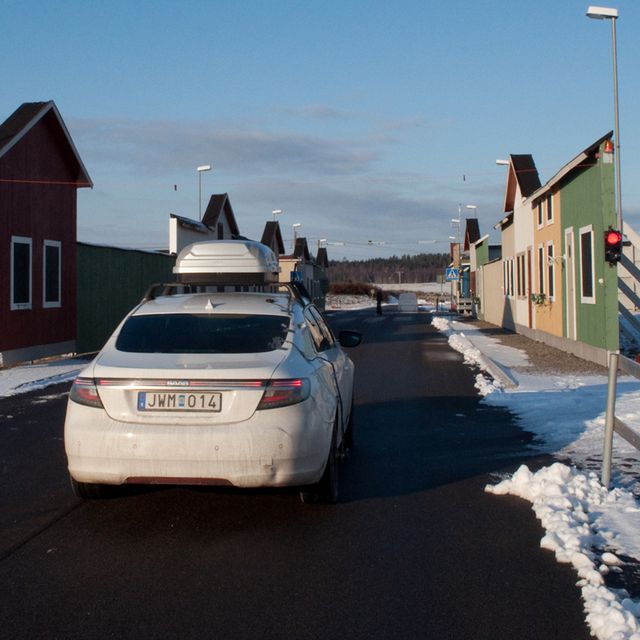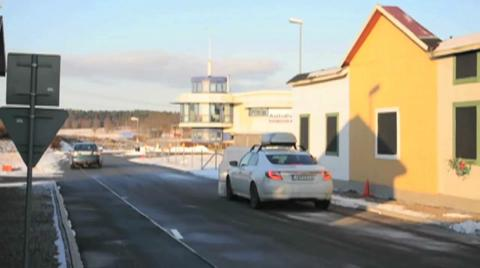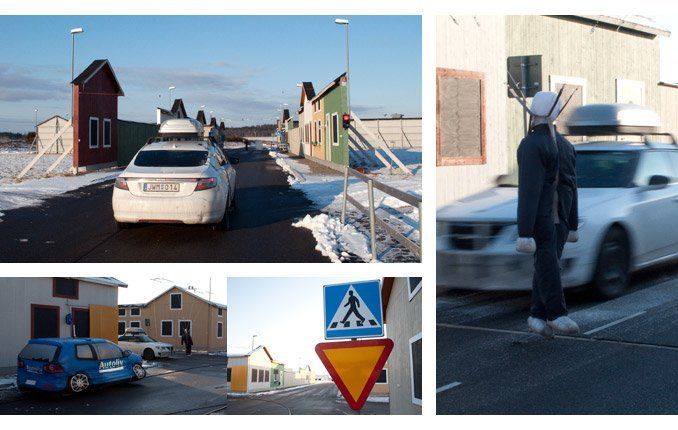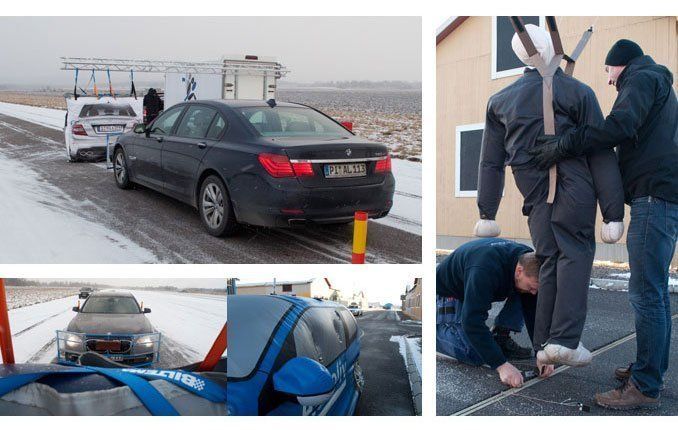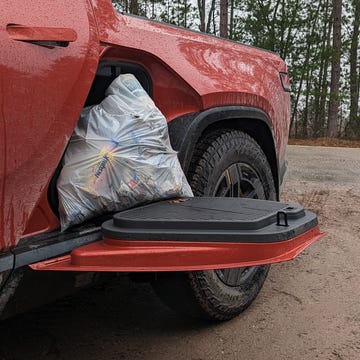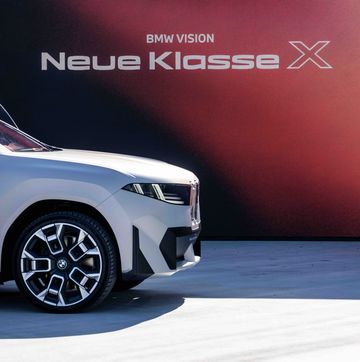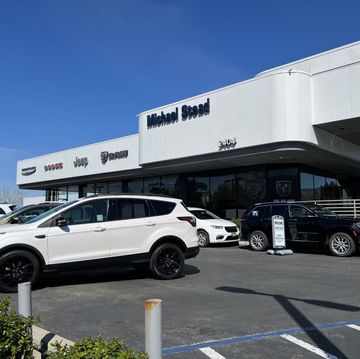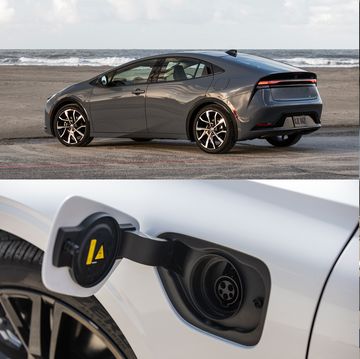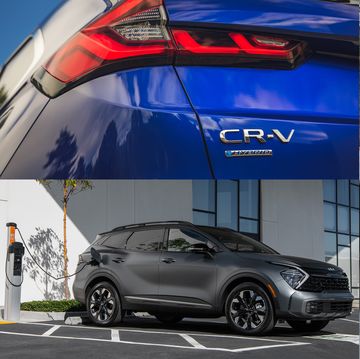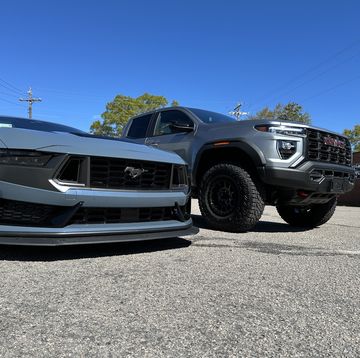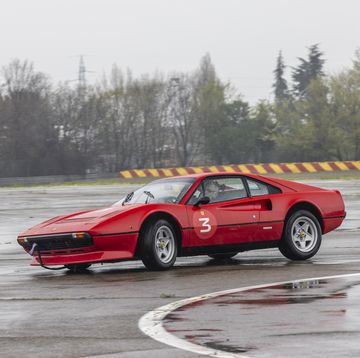Looping through the roundabout, I hit the main drag and punch the gas. Ka-thump. A guy slams over the hood and sticks to the windshield like a big insect, limbs and all. I jam the brakes, and his body tumbles to the pavement, motionless. Now I feel guilty, too—or would, if I weren’t busy texting with both hands.
But there are no police or consequences here. The “person” is a canvas dummy dangling on a string, the windows and the storefronts nothing more than Hollywood-style dressing. There is an electrically powered Volkswagen Golf parked on a side street, but it’s actually a giant balloon that rides on a plastic rail. Only my car, the road signs, a few flowers, and the humans in a heated control booth at the intersection are the real deal.
Carson City—located in the real town of Vårgårda, an hour from Volvo headquarters in Göteborg—is the world’s only purpose-built simulated city for testing active safety systems. It's run by Autoliv, a Swedish supplier that researches and manufactures safety components for nearly every car brand in the world. (Autoliv’s major clients are BMW, Mercedes, and Audi; Volvo develops most of its own systems.) Instead of choosing a Swedish name for the “town,” the company was inspired by Nevada's state capital, particularly that city's near abandonment after the gold rush. (Plus, Carson City sounds a bit like the name of Autoliv’s CEO, Jan Carlson.) Indeed, entering the 0.7-mile-long strip is like stepping onto the set of an old Western film; it's a one-block ghost town.
I’m the first American journalist to visit Carson City since it opened in 2009, and I treat the experience a bit like a scene from Grand Theft Auto, running down the dummy again and again. But Autoliv’s drivers don’t show up to play in Carson City. My car is one of the company’s test fleet, a circuitry-filled Saab 9-5 rigged with prototype cameras and GPS that allow the booth to control the throttle and perfectly time collisions with the remote-controlled dummy and the faux Golf. Sometimes, the dummy hangs out in the street. Other times, it meanders across without looking. The Golf might shoot into the intersection at random, or a second Saab might dodge an obstacle, leaving the tailgating fool behind with no time to react.
Autoliv repeats these kinds of scenarios over and over in its Carson City simulations—about 1000 times a year. Did the auto-braking system react in time, or at all? When did the car’s sensors recognize a person? Did it think the guy was a signpost? Does the technology being tested work at night, in snow, in rain? This controlled environment is the only safe place to find out.
After chuckling with the test drivers over multiple accidents and near misses, I walk around Carson City with a lump in my throat. I think about my 15-year-old cousin, hit by a car on a dark street five years ago. Could these technologies have saved him?
Salah Hadi, Autoliv’s director of vision systems, thinks about this sort of thing every day. “The problem is in the prediction,” he says. “There is a trade-off between how many false positives you allow versus true positives.”
Of nearly 34,000 U.S. fatalities involving cars and motorcycles in 2009, the most recent year for which data are available from the National Highway Traffic Safety Administration, more than 4700 of them were pedestrians and bicyclists. That’s down from a peak in 2005, when more than 43,000 people died, and based on data from its first nine months, 2011 is on track to be even lower (although total vehicle miles traveled decreased last year, too). It’s hardly great news: We’re talking about more deaths on U.S. roads in three months than American casualties in Iraq and Afghanistan in 10 years.
Although factors such as age, inexperience, and alcohol contribute to car accidents, most of us crash the same way. NHTSA estimates that 85 percent of all crashes each year are due to drivers drifting into another lane, veering off the road, rear-ending someone, or hitting a car in a crossing path, situations that active safety systems hope to prevent. Two of these crash types—veering off the road and hitting a car in a crossing path—account for about 55 percent of the fatal crashes, and rear-end crashes are the single largest group of crashes. From a yearlong, real-world trial of retrofitted Honda Accords, NHTSA concluded that certain active safety features could prevent as many as 788,000 accidents a year—if every car on the road had them. Right now, only people who drive late-model luxury vehicles or brand-new vehicles from mainstream manufacturers have lane-departure warning, blind-spot monitoring, active braking systems, and the like.
“For those kinds of systems, it’s very important you make the right balance,” says Volvo engineer Erik Coelingh. “It is not difficult to automatically brake a car. That is easy. It is a difficult decision on when to brake and not to brake, when to warn and not to warn.”
This is the complex, seemingly impossible challenge the Autoliv team must solve with each prototype. But unlike in autonomous cars, the goal here is to reinforce the driver’s ability to act, not to disengage him from driving. On the whole, the safety industry has a ton of work to do. Today’s active safety systems can’t see or read like a person, and most of all, they’re not totally in tune with where and how we drive. When we’re paying attention, we can size up a situation and plan ahead. We know, for example, why we’re speeding up to make a pass, or that a road sign looks a lot different from a person. Modern cars don’t.
‹‹‹‹‹ Trickling Down ›››››
Hardware costs for active safety systems are dropping (Autoliv expects to triple its production of far infrared cameras, used for night-vision systems, by 2014), and government safety tests are getting tougher. In the past, NHTSA has proposed grading active safety systems on a letter scale, from A to C, but Euro NCAP is going much further. Safety experts say that within the next five years they expect the European agency to award extra points to vehicles with active safety features, a move that would pressure automakers to fit them to cheaper cars to achieve higher overall scores. Soon, the average college grad’s Hyundai Accent will electronically monitor the road as intensely as the investment banker’s Mercedes-Benz CL600.
Karl Munsin, Autoliv’s senior night-vision engineer, is riding shotgun beside me in a BMW 750i, a well-worn test vehicle with huge data recorders in the back seat and beat-to-hell steering. We’re circling downtown Linköping, two hours east of Vårgårda, because we won’t park anywhere; if someone jacks the Bimmer, all the data and the one-off prototype tech go with it. We’re again testing pedestrian-centric systems, but this time I’m trying to hit a real person.
“Try to turn a little aggressively toward the pedestrians,” Munsin says. He wants to trigger a warning to test the night-vision display, which is supposed to outline heat-emitting humans in yellow rectangles.
In addition to runs through Carson City, Autoliv drivers log 100,000 miles a year on real roads, collecting nearly two million gigabytes of road data in 50 countries. In-car heat maps on touch-screen PCs show how well the cameras cover the landscape and judge distances. Other displays keep track of how often the camera recognizes a road sign (American speed-limit signs are the toughest, because their square shapes look a lot like buildings and windows to the software).
At the office, technicians analyze the data frame by frame, tracing the objects, people, or animals in the scene. That gives the programmers enough raw information to “train” the software to recognize the thousands upon thousands of real-life situations—and to ignore the unimportant stuff.
“We don’t want people turning off the systems,” says Peter Engvall, data collection and facility manager at Linköping. “[If they do], then we fail.”
No one jumps out in front of me, so Munsin gets on the radio and tells a colleague to walk into the path of our BMW. He obliges, and I’m now barreling toward him at 35 mph. I’m told not to brake, steer, or slow down. Autoliv employees volunteer themselves like this on a regular basis. My palms are sweating.
“It’s okay, you’re good, keep moving, keep moving,” Munsin says. His colleague, in very dim light, steps out, and I pass by him with inches to spare. In Sweden, everyone stops for people at crosswalks, so the civilian driver behind us undoubtedly thinks I’m a monster.
“They [were] probably thinking, ‘That asshole!’ ” Engvall says later, grinning with a group of laughing engineers.
Tonight’s first lesson: The BMW’s head-up display didn’t flash a pedestrian alert as it should have, even though the main screen properly displayed a warning. Lesson two: We need to find out what these engineers do for fun when they’re drunk.
Despite their potential, the immediate benefits of active safety systems aren’t yet clear. Joe Coughlin is the founder and director of the AgeLab at the Massachusetts Institute of Technology. AgeLab is a research group that looks at how people of different ages use these tech-heavy devices, as well as how such devices alter our psychology and social behavior. For the past 13 years, Coughlin and his team have studied topics such as how medicine affects driving and the significance aging baby boomers will have on our roads. He says we’re witnessing an “active-safety paradox,” in which the most advanced technologies first go to older, less-accepting buyers, i.e., people who can afford big German luxury sedans.
“While the technology may be very capable and very promising, we’ve never really thought about how we’re going to teach people how to use this,” he says. “The purchasing experience has not changed for many, many decades, essentially not any different from [that experienced by] my father, which is, ‘Here’s how to open the window, here’s how to play with the radio, and maybe how to adjust the seats.’ Now we have vehicles [and vehicle systems] that are being inspired and outfitted by many of the same suppliers that work on fighter aircraft.”
Education is increasing, albeit at a glacial pace. Automakers are primarily focusing on running training sessions and handing out iPads to teach customers how to use their complex infotainment systems—as Ford saw, dissatisfaction in the area can cause all-important J.D. Power Initial Quality Study numbers to plummet—but discussions of active safety tech are still rare. An exception: After Volvo introduced its City Safety suite on the 2010 XC60, it later added pedestrian detection and full auto braking to the system on the 2011 S60. To properly demo pedestrian detection for its customers, Volvo sent dealerships special kits with inflatable dummies. The dummies were then set up in open areas such as parking lots to allow customers to experience for themselves the auto-braking feature in action. (We tried this dummy-in-a-lot scenario ourselves; you can watch the video as part of our initial S60 test.) Few other automakers do this, if at all.
“We realize it’s a challenge for us and our dealers to explain to the general public what the benefits are,” says Volvo’s Coelingh.
The age gap, says AgeLab’s Coughlin, is clear: Younger drivers tend to “implicitly trust” active safety systems, whereas older drivers are more likely to get distracted by the warnings, which can be a hazard at speed. Worse, however, is the potential for drivers to succumb to “alarm fatigue,” a documented cause of death in hospitals where medical staff block out warnings from monitoring devices. But Coughlin brings up what appears to be an inevitable future, where our cars become so aware that we don’t have to be.
“What you’re asking people to do is to relearn the driving task,” says Coughlin. “Even though the [auto] industry is still telling you to check your mirrors, we will be lulled, culturally, into ‘I’m going to wait until it beeps, buzzes, or lights up.’ ”
When society gets to that point, I’m going to build the first real apartment in Carson City. At least no one there gets hurt.
‹‹‹‹‹ SAFE ZONE: NEAR-TERM SAFETY TECH ›››››
Stereo-Vision Cameras
Today’s windshield-mounted cameras can’t measure depth and distance that well. By using two cameras placed a few inches apart, engineers can better replicate stereoscopic human vision with more three-dimensional accuracy. Subaru recently announced it will offer its EyeSight driver-assistance system as an option on 2013 Legacy and Outback models. The setup integrates a stereo camera system with adaptive cruise control, precollision braking, and lane-departure warning to detect pedestrians and mitigate or possibly avoid a collision. EyeSight currently is available on a few Subaru models in Japan.
Sign Detection
The next-gen sign-detection systems will be able to recognize traffic signs from all over the world—the current systems have difficulty with U.S. signage—and display them on the instrument cluster or navigation map, keeping drivers aware of speed limits, imminent lane merges, and when they might be going the wrong way, among other things. Here’s hoping the new setups can decode Manhattan parking regulations, because we still can’t.
Animal Detection
Pedestrian detection was novel when it debuted as part of the night vision system on the 2009 BMW 7-series, but this is a much-needed progression, one that should add some defense against the stupid deer that want to destroy your car. Expect at least one of the major German luxury brands to offer it later this year; Volvo announced it was working on this technology last year, too.
Road-Surface Detection with Active Suspension Control
That cringe-inducing, expensive-sounding bang! when a pothole obliterates your fancy wheel might become a thing of the past—but not because municipalities are actually going to bother to fix roads. Cameras and other sensors will be able to scan road surfaces and warn the driver of potential hazards, including speed bumps, as well as prepare active suspension systems for the perils ahead. The next-gen Mercedes-Benz S-class will feature this technology—marketed under the comical name “Magic Body Control”—when it launches next year; we sampled an MBC-equipped prototype in 2010 and found it to work beautifully.
Precrash Airbags
You’ve probably heard of dual-stage airbags, which can deploy at different speeds, depending on the severity of a crash. But in the future, we’ll have two side airbags deploying in the same space: a “precrash” bag triggered by side-mounted radar sensors and a second bag that inflates on actual impact. Preliminary research by Autoliv suggests that such a system would reduce rib deflections, but the actuating sensors had better get it 100 percent right. An exploding airbag is physically and mentally shocking—and expensive to replace.
Another interesting development in airbag technology is the pedestrian airbag, launching first on Volvo’s Euro-only V40 hatchback. If the car detects that impact with a human is imminent, an airbag is deployed from the base of the windshield to cover the A-pillars and a portion of the glass.
Clifford Atiyeh is a reporter and photographer for Car and Driver, specializing in business, government, and litigation news. He is president of the New England Motor Press Association and committed to saving both manuals and old Volvos.
